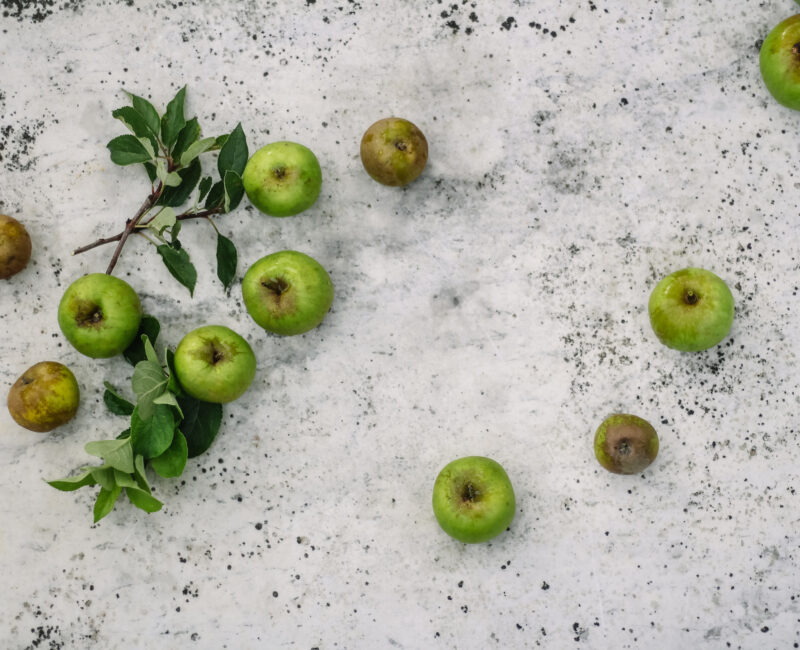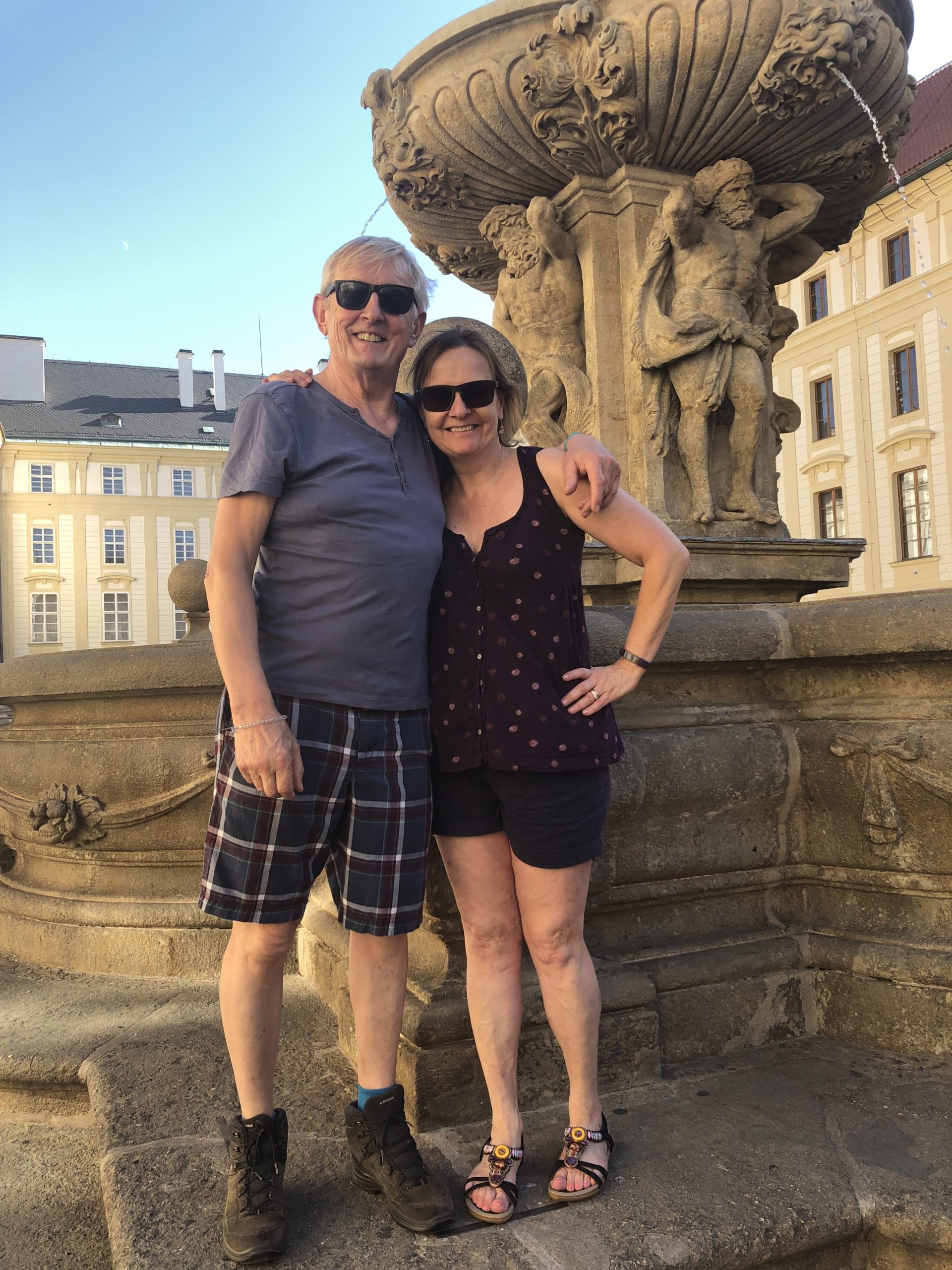
Photo: © F.Hardy
Peter Welcome to our travel podcast. We’re specialist travel writers and we’ve spent half a lifetime exploring every corner of the world.
Felice We want to share with you some of our extraordinary experiences and the amazing people we’ve met along the way. Today we’re in cider-making country in southwest England, exploring the gorgeous gardens of The Newt in Somerset.
Peter The Newt? Never heard of it? Well, you will. Covid has been a crushingly difficult period in which to launch a major new five-star hotel anywhere in the world, but The Newt is one that nevertheless has established itself as a world leader. It’s done this on a stage that is already strewn with all the hyperbole of hotel perfection. I mean, just how good can great get on this exalted scale of accommodation, ambience, natural surroundings and overall cultural experience?
Felice Well, the clue to The Newt lies in culture – or rather horticulture.
Peter Armed with a seemingly bottomless pit of Krugerands, bitcoins or whatever, the South African owners of The Newt had already cut their mark in the wine and foodie country of the Cape, and they were looking to expand their horizons in Europe. The search for a theme for a destination resort was based around what we do best in Britain. Now, from Capability Brown to Vita Sackville-West and a whole lot in between and beyond these margins – we are, let’s face it, the greatest of gardeners.
Felice So what if you bought some already famous gardens in a corner of England that had been known for woollen cloth during Tudor times, expanded them and then created not one but two beautiful hotels around the flower beds? Would you be successful?

A kitchen garden view. Photo: © The Newt
Peter Yes, you bet you would. We began by exploring the gardens, all 17 acres of them, with the hotel’s exuberant and knowledgeable botanist, Arthur Coles.
So Arthur, we’re sitting in these quite extraordinary gardens, they’ve been described as the Kew Gardens of Somerset. I have to say, I thought that was a huge exaggeration until I came here. Tell me very briefly the history of the gardens?
Arthur The history of the gardens dates back to the original garden of 1690 that was planted here by the first resident called William Player. It then went through different residents’ hands and most notably, the Hobhouses. Margaret Hobhouse was one of the most extraordinary gardeners. She was operating here in the Victorian period. Margaret had come from a Unitarian family – she had extraordinary beliefs: things like educating women and travel around the world, and she married a man who supported that. So she built the gardens, actually poured a lot of resources into the gardens here, and vestiges of that still remain.
But a lot of it was lost during the wars, and it took until the 1970s when Penelope Hobhouse, the great garden guru… when Penelope came, she married Paul Hobhouse and she set about trying to interpret the gardens as they might have been when Margaret was here. And Penelope worked on the gardens until the late ’80s, when a great Canadian plants couple called Nori and Sandra Pope came, and they then set about creating what was to become the famous Colour Gardens of Hadspen. The main part of those were in the Parabola, which is the the famous walled garden that we’re actually sitting outside of right now.
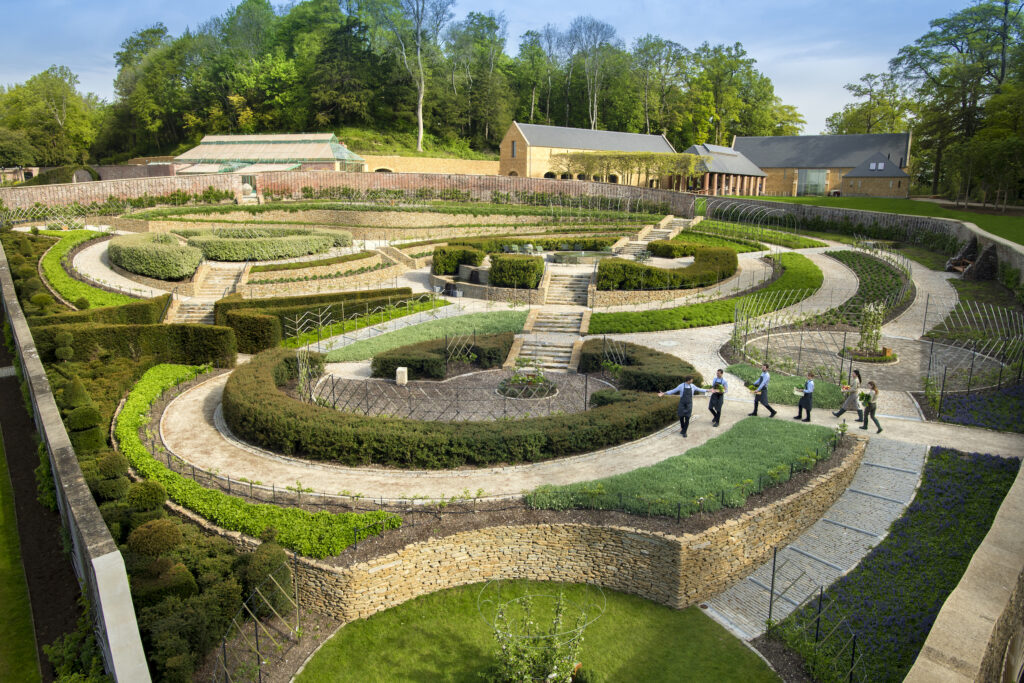
The Parabola. Photo: © The Newt
Felice We’ve seen some amazing things with you in the garden. Cacti are incredible, huge and so varied. Can you tell us a little bit about them?
Arthur Well, you’re talking about the cacti that’s in the arid house there. Yes, we’ve tried to interpret just really where those cacti have come from – they’re mainly succulents – where they come from, from around the world. The small part of the glasshouse that they’re in isn’t heated, and that often surprises people because they think, ‘Well, cacti and succulents come from arid areas. It must be very hot.’ It is during the day, but the main thing is to keep them dry. So we don’t actually heat that little house, because at night in deserts temperatures often fall below freezing. So the cacti that are in there don’t need the heat. We get away with just keeping them dry.
We’ve got a wonderful array of them in there. Some of them are pretty old, we reckon some of them probably around 70 years old and in there some younger what we would call the pups that have been brought on by our nursery, which is off-site. So you won’t see the nursery…but the nursery is really the engine room for the gardens; we bring on a lot of plants there. There’s a lot more plants in the nursery than there are out in the gardens.
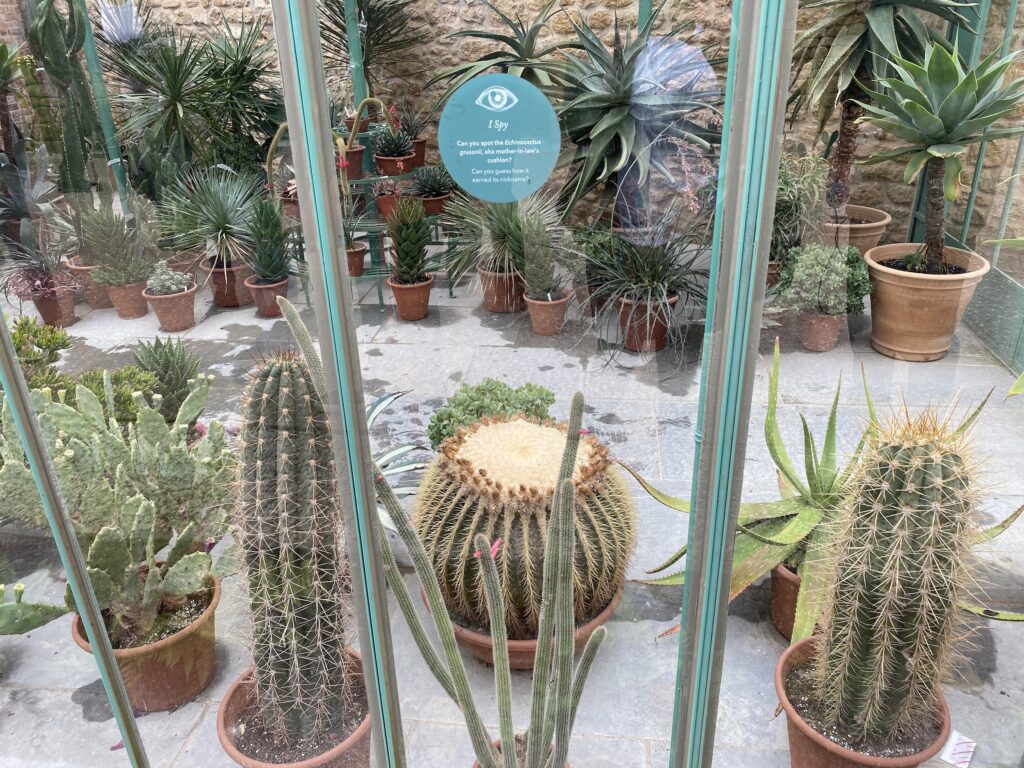
A few of the cacti. Photo: © F.Hardy
Peter Now there’s so many things to see here and how many acres are there?
Arthur So the formal gardens and the woodlands, really we say it’s about 17 acres…so you get away with saying 17 acres.
Peter It would take a long time to walk around and thoroughly enjoy because there is so much to see. I think possibly my favourite are the different coloured gardens. Perhaps you told us about those?
Arthur So the Colour Gardens, which are next to where the Georgian Palladium mansion is, which is the hotel: the inspiration for those Colour Gardens was Nori and Sandra Pope’s Colour Gardens that were here from the late ’80s all the way through to the early noughties. They had the full spectrum of colour. We’ve only got three colours; we’ve got red, white and blue. A lot of people ask whether they’re the Brexit gardens. No, they’re not – they’re the international gardens. They are seasonal and they have in them a good variety of plants that hopefully we like to think there’s always going to be interest at some point of the year.

A snippet of the Red Garden. Photo: © F.Hardy
Felice The walled garden with apples is incredible.
Arthur So the walled garden with apples is probably one of our most recognisable features here. It’s in the D-shaped walled garden. The wall itself is fascinating and interesting’ it was built by Henry Hobhouse II in the latter part of the 18th century. It is essentially shaped like the top of an egg, and in it we’ve got our collection of apples. We’d like to think a unique collection. We’re in discussions with the the right authority for applying for a national collection title for the apples there.
The national collection title we’re going for is Pre-1930s malus cultivars arranged by geographic location – quite a mouthful. We hope that nobody else is going for that title either. We’ve got 296 different cultivars of apple in there, the majority of them being British cultivars and arranged in their counties of origin. So as you walk through the maze, you’ll see on the cobblestone the name of the county where those apples originate from.
Peter And you’ve got a few French apples in there as well.

Just a few of the apple trees in the walled garden. Photo: © F.Hardy
Arthur We’ve got a couple of French apples in there, in fact more than a couple. The accent points in the centre of the circular beds – and when you come and visit, you’ll see what I’m talking about – the accent points are trained as goblets, as a globe in a double helix way. And those come from a nursery just outside of Paris that specialises…one of its specialisms is creating trained fruit trees that represent the trained fruit trees that would have been found at Louis XIV’s Palace of Versailles.
Peter Now overall it’s a garden. So often people go to gardens and children are bored, and there seem to be no facilities for them. But this is a fun garden too, isn’t it?
Arthur I hope so. The idea of this garden is really to be a full sensory experience, and to be able to sort of inspire and delight as many people as possible. Formal gardens aren’t always the reserve of children. Children are frequently told: ‘Get out of that bed, put that down, don’t touch that.’ But here you’re encouraged to walk around; you’re encouraged to pick the apples off the trees. You’re encouraged to go down and be squirted by the squirty toads at the bottom of the cascade beds.
Peter So could you explain the squirty toads? Bear in mind that this is audio, it’s not visual.

One of the toads. Photo: © F.Hardy
Arthur Absolutely nothing like the pictures presented on radio…so the squirty toads are bronze toads, a series of bronze toads, that are set in a mosaic of river pedals and as you walk around them – I am not going to give away the secret of what sets them off – but as you go around, they will intermittently squirt and spray. In a way, if you’re a garden historian, you’d look back at it and say, ‘Ah, that’s aqua junta from the Italian gardens of the 17th century and around about that time.’ But really, they’re a bit of fun and they’re to get everyone a little bit wet.
Felice Can you tell us what your job is here at The Newt?
Arthur So my job title is Head of Programme, and that involves really joined-up thinking across the business. We come up with an annual programme of talks, tours, lectures, workshops, courses, films, broadcasts. In a way to interpret what we’re doing here is a business, but also we’re a business of many hundreds of people and it’d be quite easy for silos to form. We don’t want that here. The culture is one team and the programme helps to bring all of those otherwise disparate departments together.
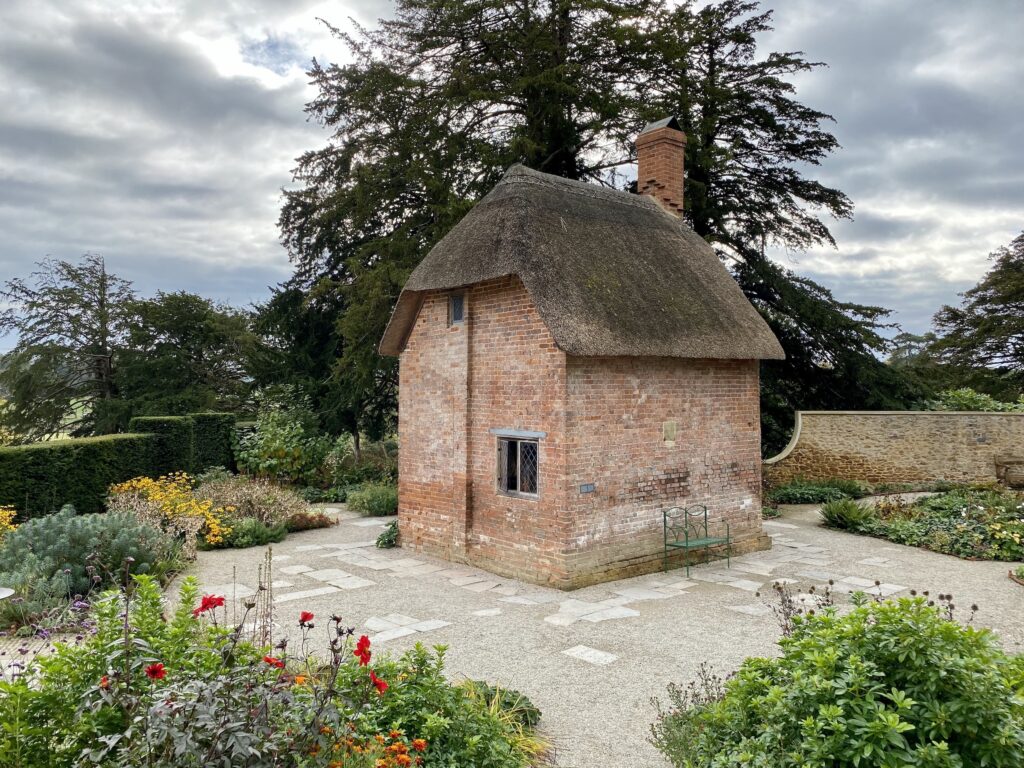
The Cottage Garden. Photo: © F.Hardy
Peter Now you’re a snowdrop man at heart, and I think you’ve spent quite a lot of your career studying snowdrops. How do snowdrops come into this? How did you get here from the world of snowdrops?
Arthur You’re quite right. I am an unabashed galanthophile. I’ve been bitten by the bug, and once you galanthophile, that’s it, there’s no turning back.
Peter Excuse me, but that is a snowdrop fanatic, is it? Say the word again?
Arthur Absolutely. A snowdrop obsessive. There’s over 1,400 different species.
Peter All right. All right. That’s enough about this! No, you haven’t even got snowdrops yet. I mean, do you have any snowdrops here?
Arthur Not yet, but just watch this space.
Peter So they managed to lure you away from your snowdrops and bring you here?
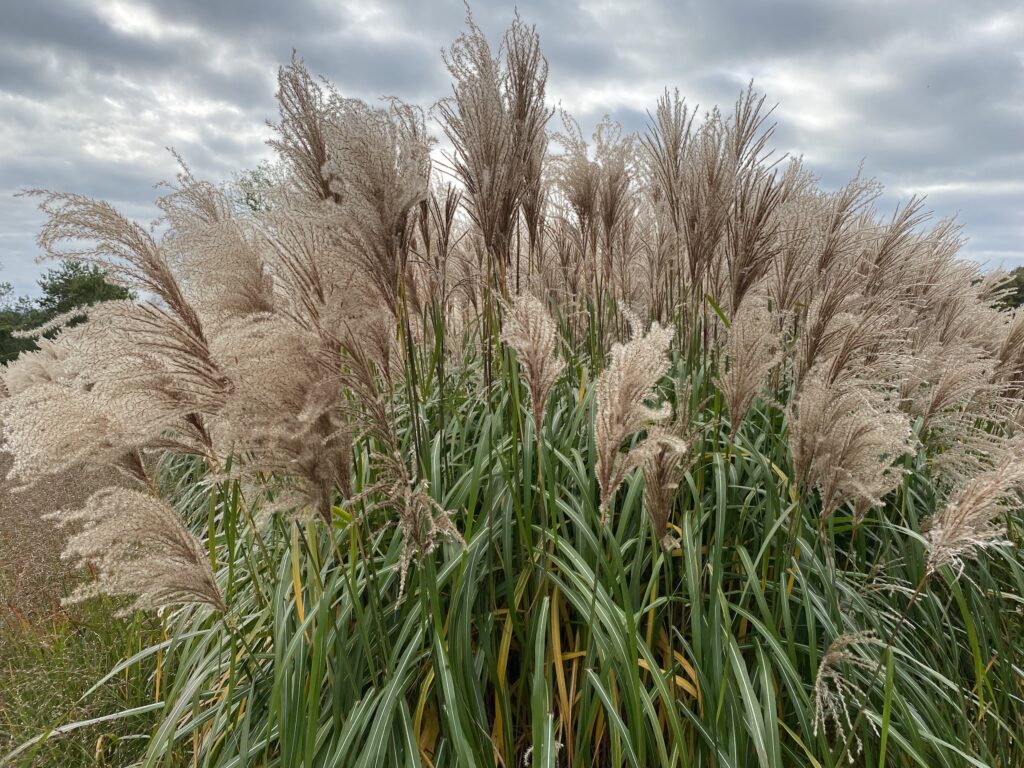
Grasses give the garden movement. Photo: © F.Hardy
Arthur This is probably one of the most exciting horticultural projects for at least a generation. Well, this is an independent from the RHS, that wonderful world-class, still the greatest gardening organisation charity that there is in the world. But we’re an independent, we captain our own ship, and what we are doing here is we’re pushing the envelope. We’re led by creativity, we’re led by exploration. We’re not going to get everything right and what we get wrong we make sure to document to help us decipher where we’re going to go in the future.
Peter And you’re going out into the world and finding unusual plants and bringing here perhaps in a sort of grandiose Victorian style.
Arthur Yes, we’ve got great collections here, and there’s some really amazing features. One of my favourite ones has to be what we call Old Knobbly. Old Knobbly is a yew hedge that’s pruned as a cumulonimbus cloud, and it’s been pruned as that for over 70 years, which means that the plants that make it up – 120 yew trees – probably are about 80 years old. You need about 10 years’ growth on them to get a good enough body to cut the shape into it. It comes from Belgium – the Belgians make excellent tree nurseryman, and somebody’s grandfather or great grandfather planted that hedge with a mind to one day selling it.
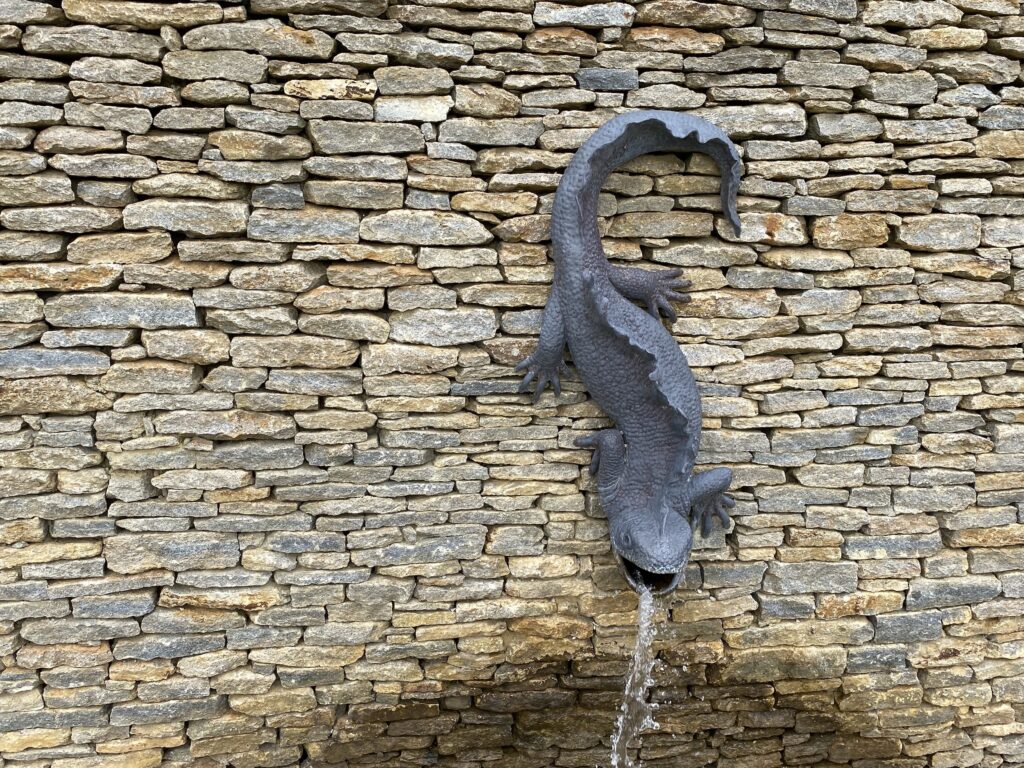
Photo: © F.Hardy
The principle behind it is fascinating. After two years of growth on each one of the trees, each one of them are undercut with a special too. That chops the tap root. By chopping the tap root, the trees respond by sending out lots of surface roots. Then, after five years, they dig around those surface roots and transplant the tree. So then they repeat: undercut every two years, transplant every five years. It means that at any stage in that hedge’s life, you can leave every single piece to one side wrap it in hessian, put it on a ferry, bring it to Somerset and it’s good to go.
Felice Can anyone come and visit the gardens here, or do you have to be a resident at the hotel?
Arthur We’ve got an annual membership. You’ll come and buy your annual membership and it gives you 12 months of access to the gardens. The thing about a garden is that it changes from day to day, from week to week, month to month, season to season and year to year. You’re never going to see the same thing twice. And so you’ll need an annual membership in order to really get a handle on just how dynamic the diverse features of the garden and also where it’s going.
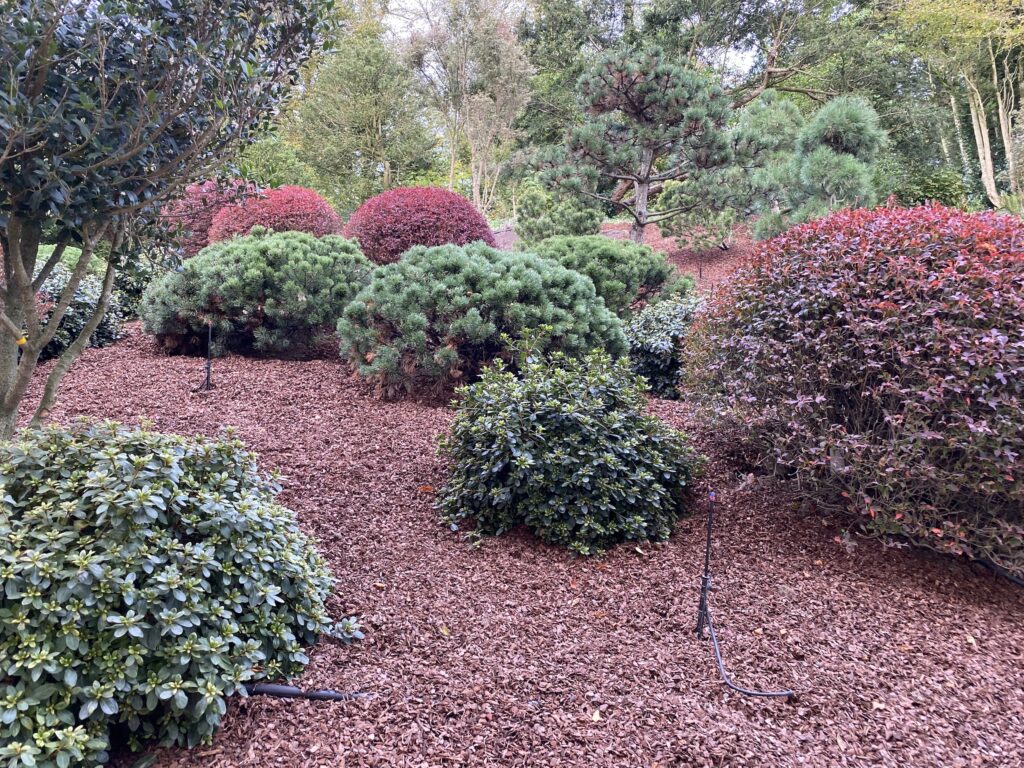
Photo: © F.Hardy
Felice If you’re a member, can you bring a guest or two with you?
Arthur If you’ve got someone who’s perhaps visiting from Australia or something who probably isn’t going to make best use of that annual membership, you can bring them in as your guest if you’re a member and they’ll pay a much reduced fee. They’ll pay a £15 entrance and they’ll get to come in for the day.
Felice That sounds like a really good day out.
Peter Well, we now live just down the road, so we’ll be coming on a regular basis, there’s no doubt about that. Arthur, thank you very much indeed.
Felice What do you think so far, Peter?
Peter Well, I think it’s very special. These are the secret gardens of Somerset, and they’re absolutely magnificent. But I’m a bit confused about the relationship between the gardens and the hotels. It’s a sort of chicken and egg situation: which came first and why?
Felice Yes, these gardens are really amazing. There’s so much to see and explore, but you’re right: we need to look around the accommodation too. Let’s go and find Andrew, the general manager.
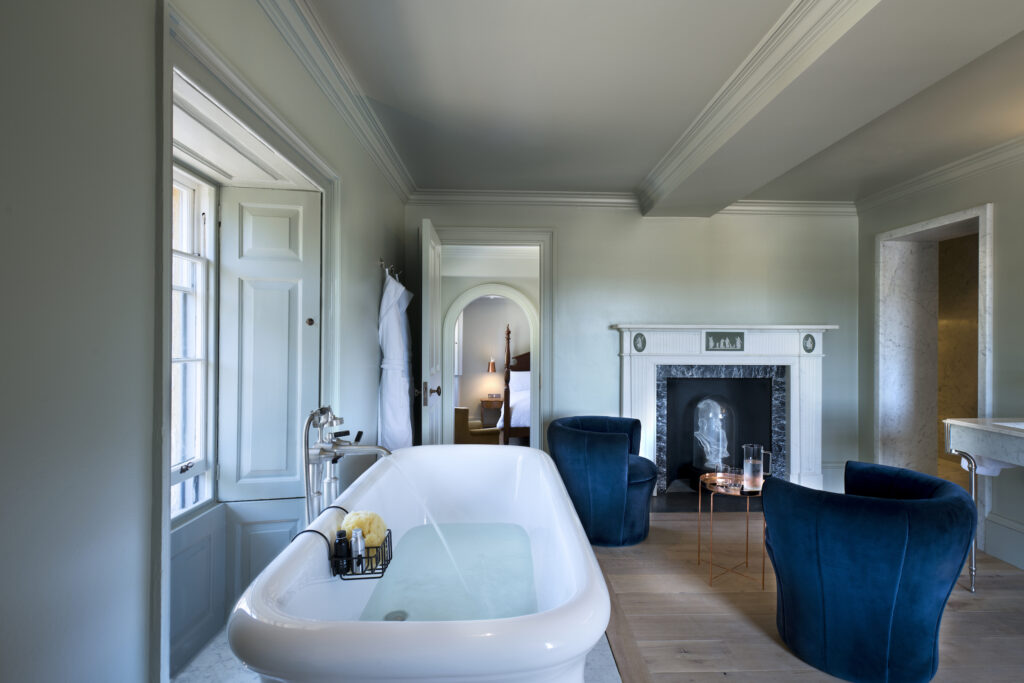
A Hadspen House bathroom. Photo: © The Newt
Peter Andrew, The Newt has been described by The Times no less an organ, as possibly the greatest hotel in Britain – or even in Europe. Now that’s a that’s a hell of a statement. How did this all come about and what is The Newt?
Andrew Indeed, it is a hell of a statement! We’re very humbled by such a statement, and obviously we work every day to make sure that we live up to that statement. And you know, one of our objectives is to be world class and best in class, and we work tirelessly at that. I guess the only way we know that is by people coming and our guest feedback that we receive. So that’s how we judge it.
I certainly don’t look at the hotel as a hotel – it’s more of a home and a house. So we invite people in as our guests – as if you’re holding a dinner party: you’d be the first one to the door, you would welcome them in and you’d sit them down, you’d greet them, you’d cook, you would look after them. And here’s all about the experience. So obviously we have wonderfully beautiful architectural buildings being all fully restored by various architects and contractors to the highest level. So we have that and it’s actually beautiful.
The interiors are all done by our owner, Karen, which are just outstanding and world class. So for us as the operators, as the team, we really have to make sure that we look after our guests. And that’s all about the experience – from the moment they communicate with us to the time that they leave and beyond. That’s how we set about making our hotel unique in the marketplace today.
We started the build in 2015/2016. I came on board in 2018 as the general manager of the hotel, and we had the last 18 months of the build and starting to set out our service model and how we wanted to pull the hotel aspect into The Newt itself. We then opened in September 2019, and since then obviously we’ve been trading more in the pandemic than out, but slowly but surely building up our reputation and our regular guests to what we see today.

Hadspen House. Photo: © The Newt
Peter Now we need to explain that there are, in fact, two hotels here. Hadspen House, the original magnificent building that dates from the 1690s, and then recently you’ve added The Farmhouse, the conversion and modern additions to a nearby dairy farm. This all part of the estate.
Felice The two completely separate buildings…are they completely separate or linked in some way?
Andrew Completely linked; we’re one hotel business. We have the main house herself –Hadspen House, 13 wonderful bedrooms. Then just outside of that, we have our stable yard, which has another 10 bedrooms. So that complex is 23 bedrooms along with our wonderful spa, gym and surrounding gardens.

The pool at the spa. Photo: © The Newt
Then just circa a mile through the orchards we then have The Farmyard, which is an old dairy farm dating back to around about 1860, comprising of another 17 bedrooms, its own restaurant, has its own Garner Bar and pool as well. In a sense it’s just an addition to what we started with. We opened the Farmyard in June 2021, so it’s still relatively new to our guests and it’s a wonderful addition to what we have very different in style. But that was because of the nature of the agricultural buildings where we had cheesemaking barns, cider presses, agricultural buildings, as well as the traditional farmhouse that the farmers used.
So it gave us a great idea to make this beautiful hotel a very different style. And what you can’t see from the podcast today is actually the topography that it sits on. It’s in a wonderful ravine valley and our guests can go in between all aspects, so some guests even stay one night in one hotel, one house, then once in The Farmyard. We accommodate in both restaurants, everyone can use the same bars, the same gardens, and we traverse between both properties with a buggy, bikes or walking.
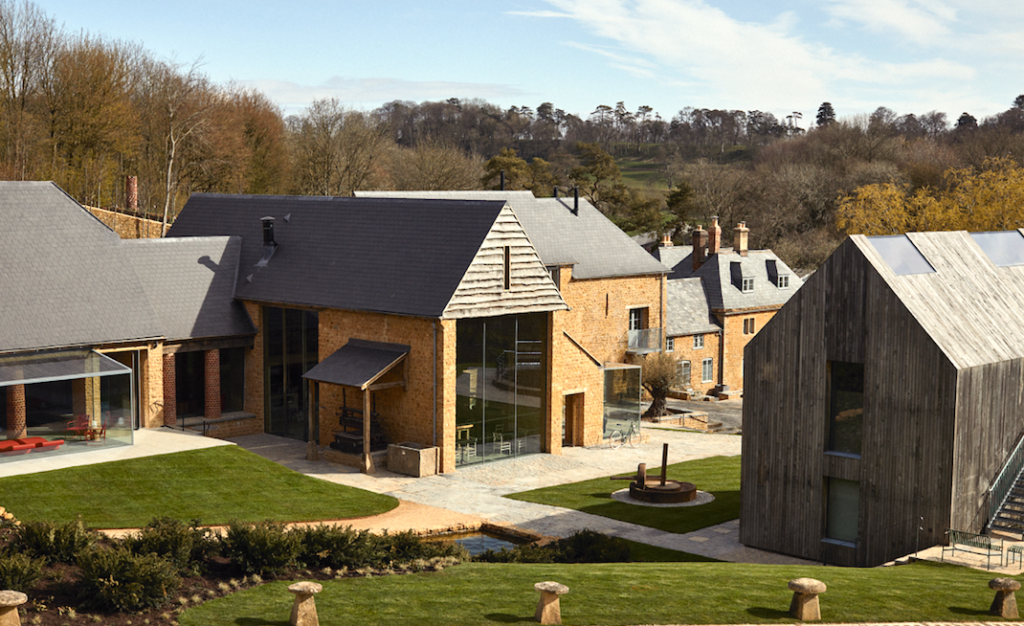
The Farmyard. Photo: © The Newt
Peter I guess that’s pretty good in springtime with the blossom, and presumably you can stop and pick an apple or two at this time of year?
Andrew Absolutely – harvest season upon us. Greg, our cider master, is very busy right now. Yes, we enjoy all those aspects.
Felice How long does the average guest stay? Just overnight or a week or longer?
Andrew We’re slightly untraditional in the sense that we request our guests to stay two nights as a minimum and three at the weekend. We have a lot of guests who stay four or five nights, it’s becoming more and more popular, and it’s very different to that traditional hotel. So we really do get to know our guest. And we believe that we have that many experiences and things to look at and to do and to amuse that you can’t really do justice now to the Newt unless you are here for a couple of days. With that, it creates an incredible relationship between us in the team and the guests. And we really get to know what they like, what they don’t like and how we can really fulfil each experience. And every time they come back, we try and add more value into their journey. That’s really exciting for our team as well to be a part of something so unique in that respect.

Llamrei Stableyard room. Photo: © The Newt
Peter Of course, rural Somerset has suddenly become really cool. You’ve got Bruton, almost next door to you, with a few famous residents. And then, of course, you’ve got Frome up the road, which is very alternative kind of place, isn’t it?
Andrew Absolutely. We are absolutely blessed with the locality, you know, as you said, Bruton, very hipster, very cool. And then obviously further afield, as I was saying earlier, Frome is an upcoming market town which has everything that anyone ever needs.
Also we’ve got amazing partnerships that we’re growing, be it Alice Temperley, who now has her haute couture space around the corner from us. We have Haynes Car Museum, which is a world-class museum that we’re linked with. Obviously all the foodie destinations, so Osip – Merlin LaBron-Johnson – one Michelin star and, like you say, the Hauser & Wirth gallery and there’s many more. We link with them or work with them or share the footfall that is coming into Somerset and really celebrate Somerset as as the heart of the foodie cultural scene.
Felice Your owners have another hotel as well in South Africa, is that right?
Andrew That’s right. We have our wonderful sister property, Babylonstoren in the winelands just outside of Cape Town. We’re starting to find a lot of guests who have visited Babylonstoren and are also coming to The Newt, so it’s a great relationship.
Felice Who is the owner?
Andrew Our owners are South African – Koos Bekker and Karen Roos. They bought the property in 2013, and we’ve now set about creating The Newt in Somerset.
Felice What we found is pretty good if you’re local, or even an hour or two away, is that you can become a member for not very much money and use the gardens.
Andrew Absolutely. Our membership….to give you an idea of how we’ve grown: just at the beginning of the pandemic we were at 6,000 members. We’re now at 66,000 – 55,000 adults, 10,000 children, annual membership. And there’s so much value to that membership, so you can come every single day of the year outside of Christmas Day. Every hotel guest that comes gets membership as a part of their stay.
So if you’re local, yes come and see us each day. Come and pick up your bread in the farm shop, have a wander around the gardens, have a tour, have a Cyder Experience. Equally, we do a lot of events here as well. We’re always doing something for our members, including now on our membership page there’s hidden experiences and also virtual experiences to be involved in. So even if you’re not so local, you can still feel a part of The Newt just by being online.
Peter Tell us about the different restaurants?
Andrew So we have in the gardens our beautiful Garden Café, which is of vegetarian or vegetable-based. Incredibly busy place. We do a little brunch into lunch and then there’s a little afternoon tea option. In our Story Of Gardening we do cakes and tea; in the Story Of Gardening we have our Cider Bar that does various picnic and takeaway options. Then in the restaurant we have the Botanical Rooms run by Ben Champkin, a real talent and find as a chef who is more refined, a bit fine dining, tasting menus. Again, everything off the land, everything from the estate.

The wood oven. Photo: © F.Hardy
At The Farmyard we have Tom Parnell Ross – again, a wonderful chef and everything that he cooks is in our wood oven. So a very different experience. Again, all the vegetables that come off the land, the meat from our estate and fish from our day boat which is in Lyme Regis. It’s an experience in itself where whatever’s ready in the wood oven then gets served. So there’s no formality of service, very organic, very family-like, like you would cook at home – when it’s ready, you eat.
Peter And then you wash it all down with either a glass of local cider or with a wine from the owner’s estates in South Africa.
Felice We had lunch at the Garden Cafe and I thought it was quite original: the fact that the main dishes, all the dishes, are vegetables, vegetable-based, and you can have meat on the side. So it’s the opposite of other restaurants.
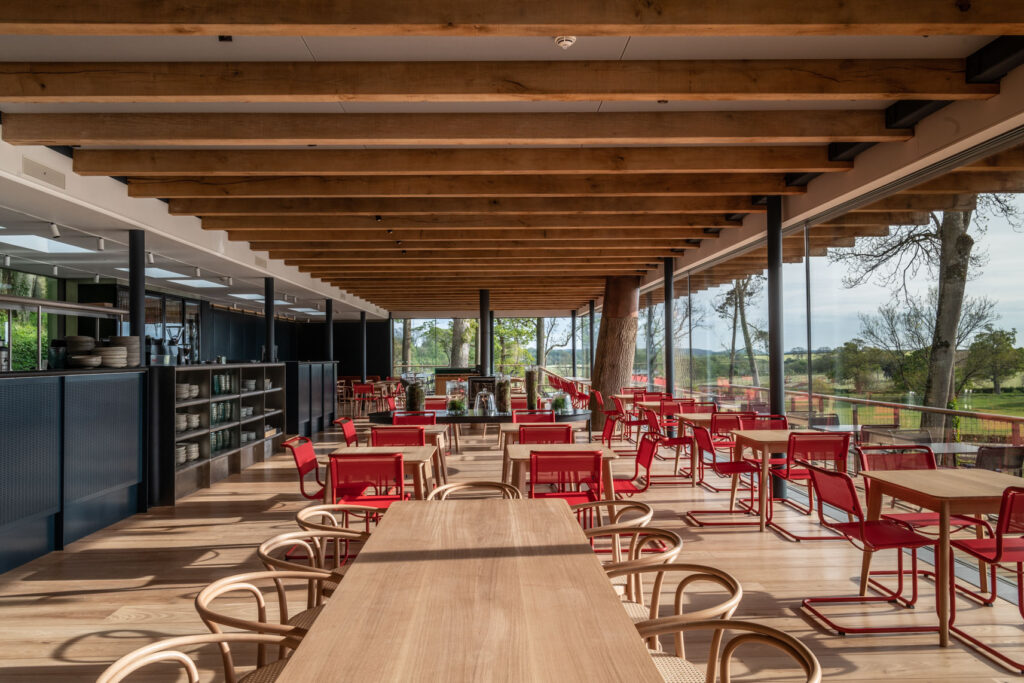
The Garden Cafe. Photo: © The Newt
Andrew Absolutely. Yes, we taken the concept of trying to take everything from the garden. And Alan Stewart, who’s our estate head chef, and most people know him from his courses that we run, and Instagram, and obviously being on site. But we set all these different restaurants with different concepts to really, really bring out the best of the estate, as well as the chefs that are cooking and work their skills. But we also give our guests multiple options whilst they’re here, but obviously celebrate the locality as well. So we work in harmony with other local restaurants.
We love to use our own cider for absolutely everything, and Greg and the team there have made award-winning ciders. We have all our own apple juices as well. And yes, of course we love our wines from Babylonstoren; they’re very, very popular.

Cyder apples. Photo: © The Newt
Peter So let’s go and sample these ciders. Christian, you’re the duty cider-maker today; tell us about the cider production on the estate?
Christian Hi, yes. So the cider production here is a blend of old Somerset cyder-making techniques utilising a lot of old Somerset cyder apples, some native apples to this area, combined with technology where it’s optimum. You know, we’re not afraid to use a bit of technical expertise in the cellar, integrating a lot of winemaking methods with the cider-making practice as well. Stylistically, just trying to make clean, route-y ciders that you’d consider drinking with a meal.
Peter And we’re talking about stainless steel tanks here. We’re not talking about old wooden barrels?
Christian We’re talking about both, actually. Yes, we do use a lot of stainless steel. You know, we’re very keen on cold fermentation here, and we do a whole cold process all the way from pressing right the way to bottle and steel is very good for that, it’s very good for retaining a lot of freshness. But we do use oak too,. Yes that is the more traditional way of doing it; obviously, they didn’t have stainless steel 100 years ago, but we do use oak vessels for imbuing a slightly toasty oaky flavour and also for softening up some of our bitter cyder apple.
We’ve been very lucky to have a whole bunch of awards come our way; it’s really great. You know, there’s been a big zeitgeist in the cider industry right now for quality, small producer, full juice, focus drinks and you know, in general people across the board are winning awards and the more the merrier.
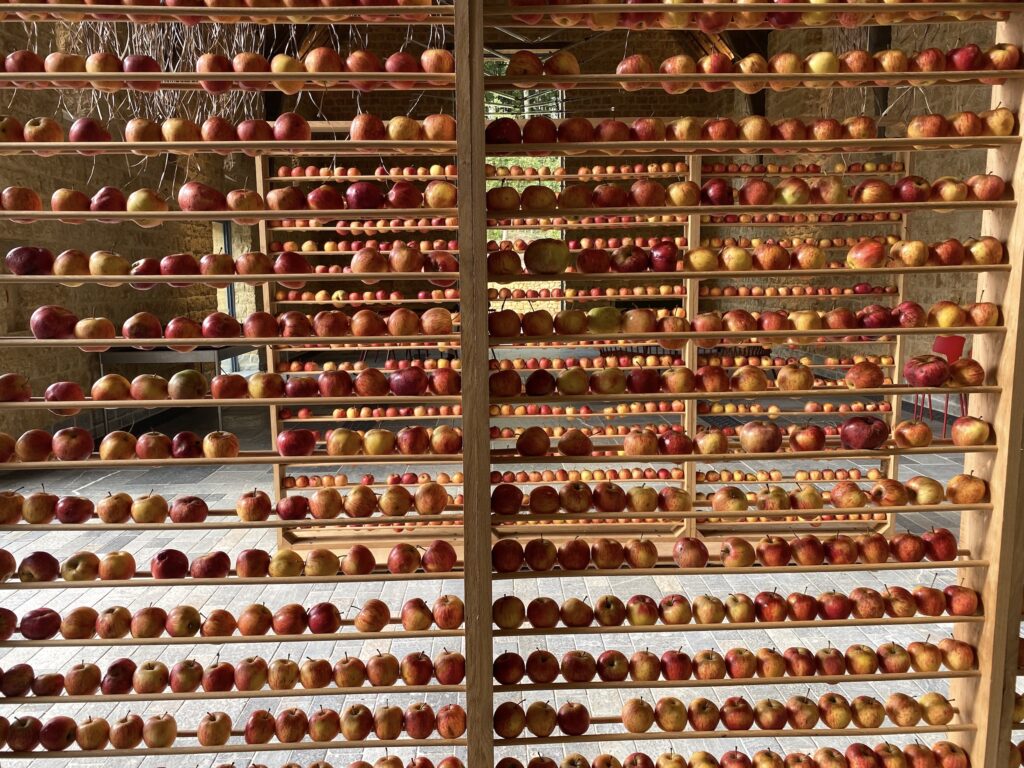
Apples on display. Photo: © F.Hardy
Felice Do you sell your cider to shops as well? Or do people have to just get it straight from The Newt?
Christian You, not just from The Newt. Obviously, we do sell a lot of product right here. We are very fortunate to have something of a captive market, you might say, which is excellent and a whole bunch of great dining venues, retail outlets. But you can now buy Newt Cyder all over the country, wine merchants, delis, restaurants as well. We’re very keen to get more on the dining scene.
Peter We’ve tasted some wonderful ones here today. Some of them really fine, dry cider that equals a glass of wine at lunchtime. I mean, this is a proper serious drink, isn’t it, with good flavour?
Christian I’m pleased you think so, sir. Yes, ‘serious’ is a great word to hear. I mean, this is our fine cyder made in the style of a sort of Austrian-German inspired Apfelwein – cider in all but name. In this, this whole process is very much like winemaking, we just use a different fruit. This year we’re looking at making about 110,000 litres of cider. Bottle-wise, difficult to say; we do lots of different sizes. We’re very keen on the large bottle format, though, maybe moving away from your traditional small bottle cider, encouraging people to pull these larger drinks out – we think that’s the best way to drink them.

Rosé Cyder 2020 vintage. Photo: © The Newt
Peter And you mentioned the Winston. Tell me about that?
Christian Yes. So the Winston is our flagship product; it is made in the traditional method. So it’s a sparkling cider made in the same way as English sparkling wine or champagne. Two fermentations; one in the bottle to give it its fizz. If you like sparkling wine, champagne and you like apples, you’re going to like the Winston. It is excellent. I know I’m biased, we’re all very proud of it. It’s got a lovely, rich flavour but still very apple-y.
Peter Named presumably after our great boozing prime minister?
Christian Indeed named after him. He did love his Champagne. He had a very big Champagne budget, I believe, and he once did say, you know, ‘I wish they made Champagne in pint bottles. It’s just the right size for two at lunch and one at dinner.’ And so we’ve got a special-pint sized bottle made: 568 millilitres for our traditional method sparkling cider in his honour.
Peter And what kind of alcohol content are you talking about?
Christian For that, 11.5%, so it’s up there with the wine. We think maybe less alcohol plus bubbles doesn’t quite gel.
Peter So what kind of price we’re talking about, retail price for a bottle of your finest dry cider?
Christian So a fine cider retails at £10.75 from The Newt itself. That is which I think for a quality cider made in a slightly wine-like style is a very good price.
Felice That’s all for now. If you’ve enjoyed the show, please share this episode with at least one other person! Do also subscribe on Spotify, i-Tunes or any of the many podcast providers – where you can give us a rating. You can subscribe on Spotify, Apple Podcasts or any of the many podcast platforms. You can also find us on Twitter, Facebook and Instagram. We’d love you to sign up for our regular emails to [email protected]
© ActionPacked Travel
![]()
- Join over a hundred thousand podcasters already using Buzzsprout to get their message out to the world.
- Following the link lets Buzzsprout know we sent you, gets you a $20 Amazon gift card if you sign up for a paid plan, and helps support our show.

